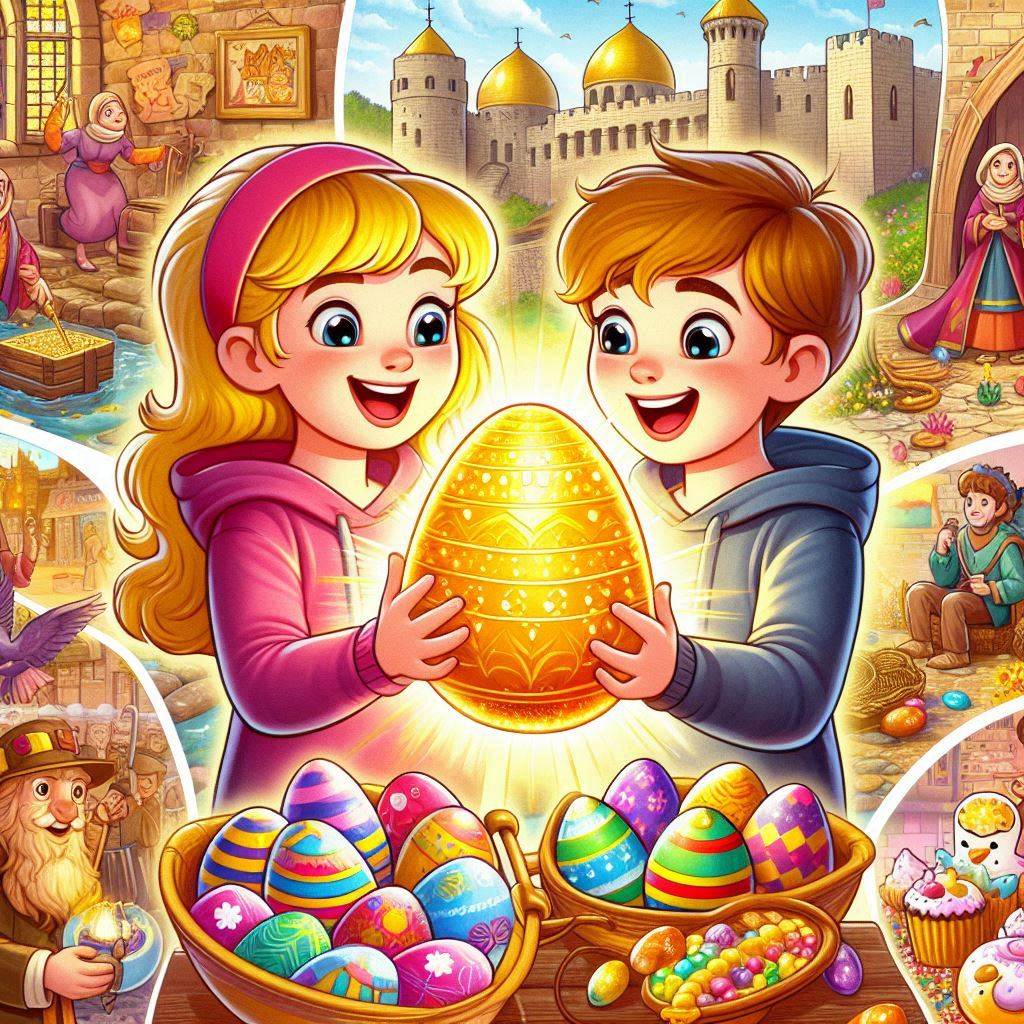Easter’s Time-Traveling Adventure…
Emily and Daniel were excited for Easter! Every year, their town had an Easter egg hunt, but this time, their grandfather had something special for them.
“I have a surprise,” Grandpa said, holding up an old, golden egg. “This isn’t just any egg—it’s a time-traveling Easter egg!”
Emily and Daniel gasped. “Time travel? Really?” Daniel asked.
Grandpa nodded. “If you hold it and make a wish, it will take you to Easter celebrations from the past! But remember—be careful and return before sunset.”
The siblings held the golden egg together and wished to see the very first Easter celebration. In a flash of light, they disappeared!
Ancient Easter in Jerusalem…
When the light faded, Emily and Daniel found themselves in a busy marketplace. People were wearing long robes, and the streets were filled with vendors selling bread and olives.
“Where are we?” Emily whispered.
“I think we’re in Jerusalem!” Daniel said, pointing to a group of people talking about a man named Jesus.
They followed the crowd and saw people laying palm leaves on the ground. It was the first Palm Sunday!
“Wow! We traveled back to the time of Jesus,” Emily said in awe.
Suddenly, the golden egg in Daniel’s pocket started to glow. “I think it’s time to go!” he said. They held the egg and wished for their next adventure.
Medieval Easter Feast…
With another flash, they landed in a large stone castle. The smell of roasted meat and fresh bread filled the air.
A young girl in a fancy dress approached them. “Hello! You must be visitors. Are you here for the Easter feast?”
“Yes!” Emily said quickly.
The girl, Princess Eleanor, led them to a grand hall where people were dancing, eating, and playing music. The tables were filled with food—hot pies, roasted chicken, and even painted eggs!
“We dye eggs to celebrate new life,” Eleanor explained. “Would you like to try?”
Emily and Daniel eagerly painted eggs with bright colors. It was so much fun! But before they could eat their feast, the golden egg started glowing again.
“It’s time to go!” Daniel said, and they held onto the egg for their next adventure.
The First Chocolate Easter Egg…
This time, they landed in a small candy shop. A man with a big mustache was stirring a pot of melted chocolate.
“Oh! Visitors!” he said. “I am making something new—an egg made of chocolate! Would you like to try?”
“Chocolate eggs?” Emily’s eyes widened. “That’s amazing!”
The man carefully poured the chocolate into an egg-shaped mold and let it cool. When it was ready, he wrapped it in shiny foil.
“You may have the first chocolate Easter egg!” he said, handing it to them.
Emily and Daniel took a bite. It was delicious! But before they could finish, the golden egg glowed once again.
“Time to go home!” Daniel said.
Back Home for Easter…
With one final flash, they were back in their living room. Grandpa smiled. “How was your adventure?”
Emily and Daniel grinned. “We saw the first Easter, painted eggs in a castle, and ate the first chocolate egg!”
Grandpa chuckled. “That sounds like quite the adventure. Now, let’s go to our own Easter egg hunt!”
The siblings ran outside, excited to tell their friends about their magical journey. Even though they had traveled through time, there was no place like home for Easter.
The End!
Follow-up Questions:
- Where did Emily and Daniel travel first on their Easter adventure?
- Why did people in the castle paint eggs?
- What was special about the candy shop they visited?

